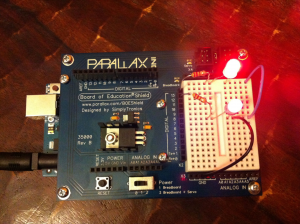I’ve been meaning to write for some time about my growing interest in making, specifically in Arduino, Processing, and paper circuits. While I’ve tinkered with coding over the years, I’ve never had an interest in electronics, at least not until last summer. I bought an Arduino last September, sponsored a high school making club during the fall, designed a Making and Writing course before I decided not to teach at the high school this spring, and introduced Arduino-based robotics and Processing into our homeschooling curriculum. (Oh, btw, as of this fall I’ve been co-homeschooling a 9th grader. I really should be better about blogging.) I’ll post more about my making activities and how they fit into my academic endeavors soon. In the mean time, here’s a post on making and the physical-digital interface I’m cross-posting from my Day of DH blog.
As a technorhetorician, a media ecologist, and a digital humanist, I’m becoming increasingly interested in the physical-digital interface of physical computing and interactive programming.
A lot of this interest is playing out in my exploring both the Arduino microcontroller and the Processing programming language. As the Arduino programming language and integrated development environment (IDE) are based on Processing, the two work quite well together. For instance, there’s the example project that interfaces an Arduino with Processing to creating an RGB LED lamp, the color of which is based upon word frequency within an RSS feed, or the much more simple example of simply turning on an LED by mousing over a Processing-created image, which I was able to do in just a few minutes. You can see the results in this Vine. Apologies for the shaky video – I held my phone with my weak hand as I used my better hand to control the mouse.
And then there’s these digitally interfaced physical books, from the basic MaKey MaKey + graphite + Scratch to Jie Qi’s Circuit Sketchbook
to Waldek Węgrzyn’s Elektrobiblioteka that uses conductive paint-based silk screen printing and a small embedded microcontroller to create touch-sensitive illustrations that call up and interact with digital content.
While I’m still learning both Processing and Arduino, as a digital humanist I’m often thinking of the ways in which we might use a visualization and generative art program like Processing to process and interact with text. For instance, there’s this fairly straightforward visualization of Goethe’s Faust and this “tube map” that’s created by inputting text. More interesting, however, are things like the codeable objects Processing library and the potential for interactive books making use of paper circuit technologies and embedded microcontrollers.
Three tasks I’m working on today is organizing a session on making, making pedagogy, and critical making and design for CCCC 2015, brainstorming a possible DIY craft and making workshop for the same, and figuring out if I’m ready to propose a paper circuits workshop for THATCamp DC at the end of this month.
And later today, as a last-minute addition to today’s home schooling (as in decided about 10 minutes ago), we’re going to have our first go at programming an ATiny85 chip and using it to make this paper-based microcontroller:
You can find the tutorial at Jie Qi’s The Fine Art of Electronics.

